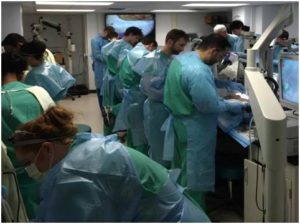Away Rotations, also known as sub-internships or acting internships, are a critical component of the neurosurgery application process. From the student’s perspective, each rotation is an opportunity to broaden your exposure to neurosurgery, rapidly develop your knowledge base and skill level, and meet a large number of neurosurgeons and mentors at the resident and faculty level, who will hopefully guide you through the application and training processes. Additionally, these rotations provide critical letters-of-recommendation to complete the ERAS application. From the program’s perspective, rotating students are essentially on month-long interviews, where the opportunity to assess things like fit, stamina, academic aptitude, and personality are much more robust than during a one- or two-day interview visit. Many programs prioritize ranking their most successful rotators, and so selecting the right programs to visit is of utmost importance to each applicant. Although most applicants complete 1 home and 2 away rotations, individuals without a home program benefit from an additional away rotation geographically near their institution.

By forming ties with people in the department that you visit, you greatly increase your chances of matching there. Be a team player with an impeccable work ethic, show that you know something (without showing-up the residents), be present, and be interested. Introduce yourself to every faculty member and do at least one clinic with as many of them as possible—in particular, the Chair and the Program Director. Be helpful but not pushy. Interact with all the residents and take call. Anticipate where a need might arise and be there to fill it. Try and do at least one research project such as a case report or meta-analysis with mentors at each location, to show your initiative and follow-through. Read before cases and demonstrate preparedness. Students who remain engaged throughout a long, complicated case will stand out and make a favorable impression as potential future trainees. Investigate and review a few memorable cases so that you can demonstrate knowledge if asked during interviews – what was done and why? And remember that your audience for these anecdotes will be a neurosurgeon, who will know whether you’ve taken the time to really learn about and understand the procedure and its indications.
Of course, there is always the chance that you will not click with the program you visit. This, too, is a benefit, as it is better that you discovered this before, rather than after, you have matched. Make a note of the elements of each program that you like or dislike and use them to inform your judgement of other programs where you will interview but not rotate.
As of the 2023-2024 season, the SNS currently recommends that each applicant complete no more than TWO away rotations, in addition to the neurosurgery rotation at their home institution. Students without a home program should are encouraged to complete 1 additional away rotation, which is typically completed at the geographically closest ACGME-accredited neurosurgery residency training program (the “adopted home program”). Most away rotation applications are now coordinated through Visiting Student Learning Opportunities (VSLO), which streamlines the process for rising M4 students. You may apply after your medical school distributes application tokens. Programs not participating in VSLO typically have separate, individual application processes; refer to their websites for additional information in that regard. The remainder of the 4th year should be geared towards rotations which provide a well-rounded experience in preparation for neurosurgery residency. Rotations in radiology, critical care, anesthesiology, or other neuroscience fields may prove beneficial in preparation for intern year.